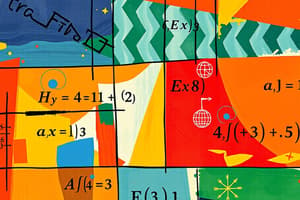Podcast
Questions and Answers
In algebra, a variable can represent a fixed value.
In algebra, a variable can represent a fixed value.
False (B)
The process of balancing an equation involves performing the same operation on both sides.
The process of balancing an equation involves performing the same operation on both sides.
True (A)
The slope of a line is calculated by multiplying the rise by the run.
The slope of a line is calculated by multiplying the rise by the run.
False (B)
A quadratic equation can be expressed in the form ax^2 + bx + c = 0.
A quadratic equation can be expressed in the form ax^2 + bx + c = 0.
Functions can have multiple outputs for the same input value.
Functions can have multiple outputs for the same input value.
The degree of a polynomial is determined by the number of terms it contains.
The degree of a polynomial is determined by the number of terms it contains.
PEMDAS is an acronym that helps remember the order of operations in algebra.
PEMDAS is an acronym that helps remember the order of operations in algebra.
Factoring a polynomial means expressing it as a sum of its factors.
Factoring a polynomial means expressing it as a sum of its factors.
Flashcards are hidden until you start studying
Study Notes
Algebra Study Notes
1. Basic Concepts
- Variables: Symbols (usually letters) representing numbers (e.g., x, y).
- Constants: Fixed values (e.g., 2, -5).
- Expressions: Combinations of variables, constants, and operators (e.g., 3x + 2).
- Equations: Statements that two expressions are equal (e.g., 2x + 3 = 7).
2. Operations
- Addition & Subtraction: Combining or removing values.
- Multiplication & Division: Scaling values or determining how many times one number is contained within another.
- Order of Operations: Parentheses, Exponents, Multiplication and Division (left to right), Addition and Subtraction (left to right) - acronym: PEMDAS.
3. Solving Equations
- Isolate the Variable: Manipulate the equation to get the variable alone on one side.
- Balancing: Whatever you do to one side of the equation, do to the other.
- Types of Equations:
- Linear Equations: Form y = mx + b.
- Quadratic Equations: Form ax^2 + bx + c = 0.
4. Functions
- Definition: A relation where each input has exactly one output.
- Notation: f(x) represents a function of x.
- Types:
- Linear functions: Straight line graphs.
- Quadratic functions: Parabolas.
5. Graphing
- Coordinate System: X-axis (horizontal), Y-axis (vertical).
- Plotting Points: Ordered pairs (x, y).
- Slope: Measure of steepness; calculated as rise/run (change in y/change in x).
6. Polynomials
- Definition: An expression consisting of variables raised to whole number powers and coefficients (e.g., 4x^3 + 3x^2 - x + 7).
- Degree: Highest exponent in the polynomial.
- Operations: Addition, subtraction, multiplication, division (long division or synthetic division).
7. Factoring
- Definition: Expressing a polynomial as the product of its factors.
- Techniques:
- Common factor extraction.
- Difference of squares.
- Quadratic trinomials (e.g., x^2 + bx + c).
8. Inequalities
- Definition: Similar to equations, but show a relationship rather than equality (e.g., x + 3 > 5).
- Types:
- Linear inequalities.
- Compound inequalities (combined using "and" or "or").
- Graphing: Use a number line or coordinate plane; open circles for < or >, closed circles for ≤ or ≥.
9. Systems of Equations
- Definition: A set of two or more equations with the same variables.
- Methods of Solving:
- Graphing.
- Substitution.
- Elimination.
10. Key Theorems and Properties
- Distributive Property: a(b + c) = ab + ac.
- Associative Property: (a + b) + c = a + (b + c).
- Commutative Property: a + b = b + a.
By mastering these concepts, students can build a strong foundation in algebra, which will facilitate further study in mathematics.
Basic Concepts
- Variables are symbols (typically letters) that represent unknown numbers, such as x and y.
- Constants are fixed numerical values, for example, 2 or -5.
- Expressions consist of variables, constants, and operators, like 3x + 2.
- Equations declare that two expressions are equal, exemplified by 2x + 3 = 7.
Operations
- Addition involves combining values, while subtraction entails removing or finding the difference between them.
- Multiplication is the process of scaling values, and division is finding how many times one number fits into another.
- The order of operations is crucial: follow the sequence of Parentheses, Exponents, Multiplication and Division (left to right), Addition and Subtraction (left to right), remembered by the acronym PEMDAS.
Solving Equations
- Isolating the variable is essential: rearranging the equation to have the variable alone on one side.
- Balancing is a key principle: any operation applied to one side must also be applied to the other.
- Types of equations include:
- Linear equations, which are represented in the form y = mx + b.
- Quadratic equations, presented as ax² + bx + c = 0.
Functions
- A function is a specific relation where every input corresponds to exactly one output.
- Function notation is expressed as f(x), indicating a function based on the input x.
- Types of functions include:
- Linear functions, which produce straight line graphs when graphed.
- Quadratic functions, which form parabolic graphs.
Graphing
- The coordinate system consists of an x-axis (horizontal) and a y-axis (vertical).
- Points are plotted using ordered pairs denoted as (x, y).
- Slope is a measure of the steepness of a line, calculated as rise/run (change in y divided by change in x).
Polynomials
- A polynomial is defined as an expression comprising variables raised to whole number powers and their coefficients, such as 4x³ + 3x² - x + 7.
- The degree of a polynomial is identified as its highest exponent.
- Operations on polynomials include addition, subtraction, multiplication, and division (using long division or synthetic division).
Factoring
- Factoring involves expressing a polynomial as a product of its factors.
- Techniques for factoring include:
- Extracting common factors.
- Using the difference of squares method.
- Factoring quadratic trinomials such as x² + bx + c.
Inequalities
- Inequalities express a relationship other than equality, such as x + 3 > 5.
- Types of inequalities include linear inequalities and compound inequalities combined with "and" or "or."
- Graphing inequalities uses a number line or coordinate plane: open circles represent < or >, while closed circles represent ≤ or ≥.
Systems of Equations
- A system of equations is comprised of two or more equations sharing the same variables.
- Methods for solving systems include graphing, substitution method, and elimination.
Key Theorems and Properties
- The Distributive Property states a(b + c) = ab + ac.
- The Associative Property asserts (a + b) + c = a + (b + c).
- The Commutative Property holds that a + b = b + a.
Studying That Suits You
Use AI to generate personalized quizzes and flashcards to suit your learning preferences.




